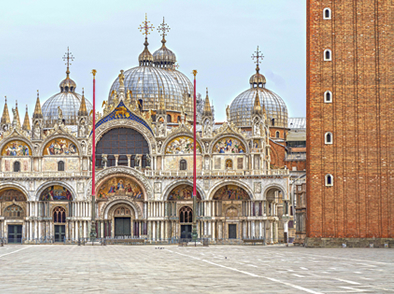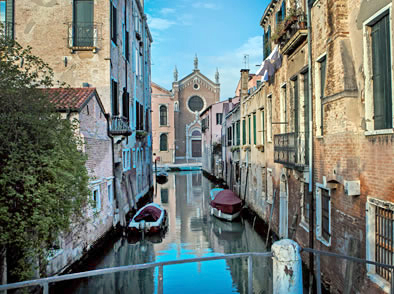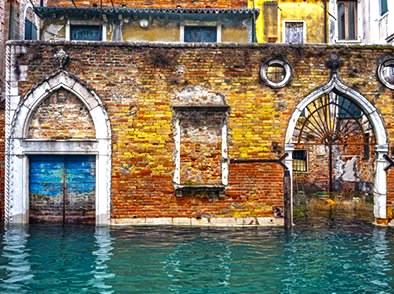When was Venice born ?
This year, on March 25th, we celebrated Venice’s 1600 years birthday with TV programs, articles, documentaries, posts and remote guided tours.
Important ancient cities and sites have always linked their foundation to mythological stories. Story telling has always existed. As such Greek, Indian and Egyptian mythologies are some of the most renowned examples, but there are many others.
We commonly explain the creation of the lagoon settlements that gave birth to Venice as the result of an exodus. The first written chronicle referring to such an exodus is the one narrated by the Byzantine Emperor Constantine VII Porphyrogenitus (mid Xth century). He reported inhabitants of the Roman mainland towns had fled from the Huns. This is the most popular story handed down by the locals.
How was this date of 25th of March 421 born? Who came up with this ?
Jacopo Dondi dell’Orologio was born on Chioggia island. He studied in Padua and graduated in medicine. He was also an amateur watchmaker and in 1334 disclosed a document referring to the foundation of Venice as happening in 421. Before Dondi, the date 421 in Martino da Canal Estoires de Venise (around 1270).
Dondi seems to credit the Paduan chronicler Giovanni da Nono ( beginning of 14th century), according to whom the city of Venice was built by decree of the Paduan consuls and was originally governed by three of them (at that time Padua has not yet under Venetian dominion).
In 1420, after the fire of the Palazzo della Ragione in Padua, an unknown forger transformed the legend of the Paduan foundation of Venice by making the chronicle of Dondi an official document. Subsequently, numerous copies of the same document appeared in Latin and vernacular. Before 1509 the information of Venice as a city created by Paduans, had already been transcribed in the main register of the Civic Chancellery of Padua.
Over time the legend acquired new additions, as for instance the one of the church of San Giacomo di Rialto, in the heart of town, supposedly founded on the same day (25th of March 421) when in reality the first document relating to the same dates back only to 1177.
In 1420 the powerful and independent city state of Venice was nevertheless happy with the version of its Paduan origins.
According to Padua’s founding myth the city was founded by the Trojan Antenore, after he had fled to the Adriatic following the destruction of Troy. The other Trojan hero Aeneas, would have fled to Lazio, married Lavinia and generated the progeny from which Romulus and Remus would have been born. So whereas Padua would than have been founded directly by the Trojan Antenore, Romulus – founder of Rome – would only be the grandson of the Trojan Aeneas. Padua’s founders would therefore be older than those of Rome and Venice originate from a city older than Rome. Imagine that…not a bad story to tell !
On the other hand, the grand Venetian families used to trace their origin back directly to those Roman patricians living in the Decima Regio cities (Veneto and Friuli regions of today). When in fact most of Venetian patricians were descendants of a nobility of wealth and not always of blood.
The myth of the origins Venice begins there and perpetuates for centuries to come. At the beginning of the 14th century the grandest Italian poets Dante and Petrarca idealized the city. Petrarca says she is “the only refuge in our day of freedom, justice, peace, the only refuge of the good”.

We also need to consider the auspicious day of the Annunciation of our Lady – 25th of March- coinciding with the birth of Venice. Sabellico – the first official historian of Venice of the late 15th century- endorsed this date by writing “God willed it, so it is right” . This would suggest Venice was born out of a divine project, a guarantor of human justice and peace. Two qualities that laid the foundation of Venice’s myth and that we often find represented as human effigies adorning Venetian government buildings.
The year 421 suits the Venetians of the 14th century perfectly since it is three decades prior to the descent of Attila, the king of the Huns. This gave birth to myth of the archetypal freedom of its people. People that never mixed with the Barbarians: a city born free, created by Romans’ descendants who always remained free.
More realistically, population displacements were no sudden events. The lagoon inhabitants were probably already there before the Visigoths crossed the Julian Alps and invaded the Roman province of Venetia et Histria. This Roman region stretched from the small river Fiumara in Croatia through present day Friuli, Veneto, Trentino Alto Adige, all the way down to Cremona, Brescia and Mantova.
It is surely possible that the Barbaric invasions caused a growing of lagoon settlers, but they were not the cathalist of the massive flight of mainland people towards the lagoon.
Several historians link the creation of the most important lagoon settlements with the Lombard invasions of the mainland in the year 568. Because of this, the inhabitants of Altino fled to Torcello island with their first bishop remains and city treasures. Following the destruction of Padua in 601 its inhabitants fled to Malamocco island. A couple of years later, the inhabitants of Oderzo, led by Bishop Magno, moved to Equilio, on the edge of the lagoon.
Today contemporary historians tend to think that Venice was never actually born, but rather took shape through a long and complex process of successive additions,
In the next episode we will delve more into the origins of Venice to discover one of its most ancient sites.
Join me and I will provide you with one of the best private guided tours of the most authentic Venetian places!
Photo Credits: Biblioteca Nazionale Marciana, Lat. XIV 77 (=2991) cc. 22v-23r
Get in touch!
Which Venice will you discover?
INTRODUCTORY TOURS
These tours are intended for first time visitors who wish to become acquainted with Venice’s main sights and landmarks, gaining an overall picture of its history and modern-day life.
IN DEPTH TOURS
Art, in all forms has been a unique ingredient of Venice’s success. Discover the magnificence of the grand Venetian architects and painters. For the ones that live in the now the contemporary art, contemporary architecture and the truly authentic glass studios where masters are at work.
UNUSUAL TOURS
These tours are intended for visitors who wish to experience areas and sites rarely seen by tourists, in both urban locations and beyond. Take this opportunity to discover truly authentic art studios, furnaces and lagoon islands with us.




